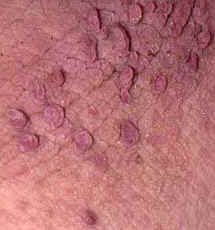| Into cars? Check out our sponsor: MEKK Autoworks, Inc. |
Tulloch's
Health Tip: Skin Tags (cutaneous papilloma or an acrochordon) Updates in yellow |
Age Strong with Strong Age
Senior Muscle Maintainer |
|||
| Virus Defense Virus Facts Amino Acid Attack Reducing Arginine Compete w/ Arginine Virus Attack Aging Muscles Skin Tags |
Skin tags most often occur after the age of thirty, but they are also found in infants as young as one day old.
They are in the same family of moles. They are soft, small, flesh-colored or other-colored
protrusions, usually occurring in multiples on the neck, eyelids, armpits and groin. Skin tags are generally harmless but may be irritating, especially if they catch on clothing or rub against your collar. Most skin tags are benign (non-cancerous), but if they are painful, unsightly or restrict movement, you may want to have them removed. You may want them removed for cosmetic reasons. Surgery is usually recommended to remove any skin lesion that shows any sign of turning cancerous, for example, a mole that has changed shape or color. Depending where the skin tags are located they can be removed
by surgery. If the skin tags are small enough they can be snipped off with the aid of topical anesthetic.
When removed by snipping, skin tags do not usually bleed. They may also be
"shaved" off or excised. For an excellent description of
surgical removal of skin lesions see: http://hcd2.bupa.co.uk/fact_ Removal of skin tags is considered to be very low risk. Your General Practice physician is qualified to remove skin tags using any of the following methods.
These procedures generally involve little or no patient discomfort. However, they all tend to leave scars. I would think that any of these procedures can be done by the careful layman. I tried the "strangulation" method. It's very difficult to tie the thread while pulling outward on the skin tag. A third hand would really help. Despite having the thread fall off every day or two - especially as the tag shrank - I found the tag and thread on my pillow in about five days. No pain. Impossible for small tags. Type of thread - cotton. No scar, no residual lump, no reccurance. |
I imagine that the recently available CO2
wart removal devices would work (Note: Chemical wart removers don't
work.). For the brave, using a new, sterilized razor to cut off the
tag after applying a topical anesthetic and cleaning the skin with alcohol
seems safe. They don't tend to bleed very much.
The generally accepted belief is that there are no chemical, nutritional, or biological methods to removing skin tags. However, Loren Pickart, Ph.D. suggests a chemical approach. 1. She finds that a topical application of two products reduce or remove skin tags. Dr Peckart.s products can be found on her website: http://www.skinbio.com/ Additional methods have helped some folks. These include:
Notice: The brands presented here have not been tested by the author. Nor should this information be considered a recommendation by the author. Use this information sensibly. You are responsible for your own health! |
|||

